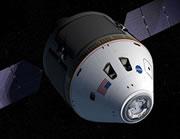 The United States will soon be on its way back to the Moon.NASA
The United States will soon be on its way back to the Moon.NASASpace agencies around the world are abuzz with plans to return to the Moon.
The United States, China, Japan, India, Russia, Europe and even some private companies have all announced missions. Lunar orbiters should swiftly be followed by unmanned landers, and in a dozen years the first astronaut since Eugene Cernan in 1972 should (if all goes as planned) be walking on the far flung rock.
With concrete plans — and the infrastructure — to get people to the Moon, the United States is well in advance of any other country. The plan is for Ares rockets, the crew exploration vehicle (called Orion ) and a lander to carry four men to the Moon by 2018 or so, says Tony Lavoie, NASA's Lunar Precursor and Robotic Program manager. The astronauts will first conduct seven-day 'sortie' missions, but in time may establish a lunar outpost, allowing for extended six-month stays.
The United States has enthusiastic competition from China and Japan. Long Lehao, vice-director of China's lunar programme, says his country plans to complete a manned mission by 2024, including a walk on the Moon's surface. China has precedent for putting people in space: in 2003, it became the third nation to independently launch a citizen into orbit.
Junichiro Kawaguchi, head of Japan's lunar and planetary exploration programme, has announced a deadline of 2020 for sending astronauts to the Moon, and 2030 for constructing a Moon base. But observers have noted that this programme remains unfunded; it seems unlikely that they have the capacity to complete such a bold project without international help.
All for one
The twenty-first century Moon race (see 'tab/060828-11T1.html">Blue-sky thinking') will not be quite like that of the 1960s and 70s, when countries played for national prestige.
 Read our Moon special to find out more.NASA
Read our Moon special to find out more.NASAUndoubtedly, patriotism is an important driving force behind China's lunar programme, and some US Moon mission advocates are using the competition to spur a return.
But there is a much greater spirit of cooperation when it comes to big missions, says John Zarnecki, a space scientist at the Open University, UK. "Countries realize they have to collaborate: their space budgets aren't guaranteed," he says.
NASA's Lavoie agrees: "We want to engage commercial and international partners to see if we have mutual interests, which would reduce the burden on all." Countries and companies that are not planning to visit the Moon themselves may still partly fund lunar missions, or add scientific instruments to other missions' payloads.
India is keen on discussing future missions with NASA, for example. And the European Space Agency, while focusing on Mars, is working with Russia to develop a new spacecraft: the Advanced Crew Transportation System. Moon missions may be suggested as a testing ground for their plans.
Some European countries are even forging independent paths: Italy and Germany are developing lunar exploration and lander programmes, mainly focused on scientific research.
For good reason
What will going to the Moon achieve? Some science, certainly. The Moon's surface will be mapped and examined for resources: power, water, heavy metals and helium-3 have all been suggested. Moon-based infrared- and radiotelescopes are also being considered.
There are commercial opportunities too. Transorbital, a company based in La Jolla, California, is planning to deliver personal items (ashes, jewellery, artwork and other memorabilia) to the Moon starting in late 2008, for a hefty fee of US$2,500 a gram.
And by 2010 or 2011, the Virginia-based Space Adventures, which has already taken tourists to the International Space Station, promises two $100-million seats on a trip around the Moon. With proven and reliable vehicles at their disposal, observers say the scheme is feasible.
Ideas for tourism, sport and PR activities on the Moon spring out of every lunar conference. But the Moon is also being seen as a testing ground for human missions, or settlement, on planets such as Mars. Here again, commercial ventures could help in building lunar outposts.
ADVERTISEMENT
It's hard to say whether these plans are financially viable or worthwhile. But whatever happens, there will need be careful compromise between international rivalry and global partnership if the Moon's second wave of visitors is to achieve another giant leap for mankind.
Visit our newsblog to read and post comments about this story.
